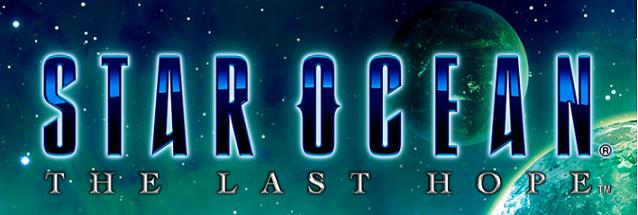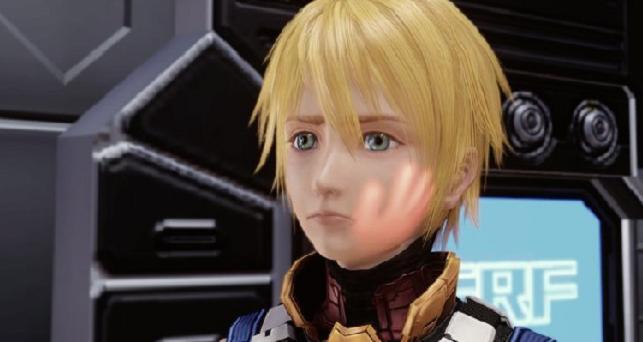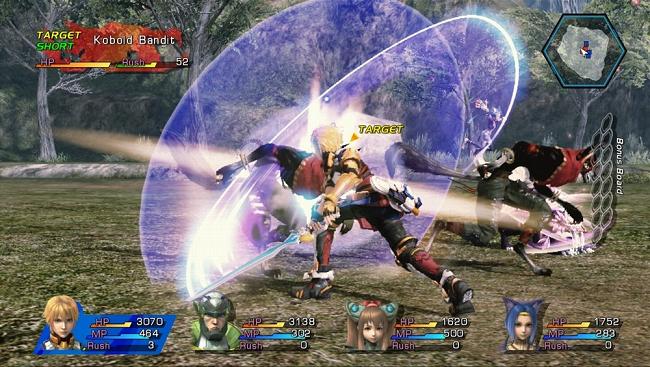
The Japanese role-playing game has been experiencing tough times lately. Many fans of the genre need a solid title to hold them over until the 2010 release date of Final Fantasy XIII. Star Ocean is one such title – potentially. The Last Hope is much like its predecessor, Star Ocean: Till the End of Time for the PS2, but fitted to an Xbox 360. While braving the “vast star ocean,” (spooky voice, wavy hands) the player can expect an RPG of universal proportions that includes the exploration of new worlds via spaceship/menu, partying up with the usual JRPG/anime-archetypes, a handful of lengthy cut scenes, and a unique battle system - all spanning three discs.
After the first hour or so of JRPG-required introductions like cut scenes and battle tutorial, the player assumes control of Edge Maverick (yeah, I know), an aspiring space pioneer. The motivation? Humans ruined Earth, and we need a new place to live. From here, the flow of the game is as follows: explore planet, gain a character, do a dungeon, fight a boss, explore another planet, gain another character, etc. I’ll admit that I’ve recently been cynical about the genre, as this is probably true for most JRPGs by substituting the word “planet” for “town.” The good thing is that an entertaining story has been woven into the said template. That is, if you don’t mind joining up with characters you often see on your television screen while watching [adult swim] anime on Saturday nights. Many of the characters you’ll encounter may not be the most original group of HP-having do-gooders you’ve encounter in Eastern gaming. The story may be sprinkled with some clichés here and there, but there were times where I have actually caught myself sympathizing and being frustrated with characters over the course of the story. I also found myself playing later into the night, as Star Ocean presented me with plot events which had me wondering in which direction the writers of the story were certain characters. Between planets, the player is given a chance to interact with other characters through dialog and cut scenes in order to better understand the people you are traveling with. Of course, this is totally optional. However, there are also a bunch of cut scenes that I would say are more than giggle-worthy.

The area in which Star Ocean really shines is in its battle system. Game developer, tri-Ace, is known for making games that have interesting and unusual battle systems (i.e. Radiata Stories, Valkyrie Profile 2) which often require more attention from the player than any turn-based RPG would. At first glance, the battle system comes off as a bit helter-skelter, and at times it may also play like it; but it’s enjoyable. Battles in Star Ocean are actually similar to playing a beat ’em up game. During battles, the player assumes control of one of the four characters you have in your active party. The player can control a different character with a bumper-button press. Each character controls and feels differently, so switching characters is a plus when you’ve grown tired of using Edge. Unfortunately, you’re sometimes forced to switch to another character when you’d rather not. This is one of the battle system’s flaws. AI characters are only limited to a choice of one of about six in-battle tactics such as “don’t do anything,” “stay out of trouble,” or “fight freestyle.” By not providing the player with a more detailed way of programming how an AI character behaves, the AI character can often lose a tough fight for you during a crucial moment even if you’re at an appropriate level for that fight. This flaw becomes more apparent for the more difficult enemy encounters, however. Generally, no matter which tactic you choose, AI characters seem to never use items or cast status-removing spells. Though computer controlled symbologists (that’s Star Ocean lingo for a mage) are decent at healing, they sometimes don’t know which type of healing spell is appropriate for the current situation. Imagine having to refrain from pummeling an enemy in order to un-silence your symbologist as they stand in the corner twiddling their thumbs because their tactic is “stay out of trouble.” One can’t help but yearn for the gambit-system in Final Fantasy XII during these times. Being over-leveled is one way to prevent these situations from happening, but excessive grinding might turn off casual gamers.

Star Ocean does tend to make things easier at times. The menu now sports a synopsis of the story up to where you are at in the game, which is a game changer if you decide to take a break for a few days, weeks, or months. I will never finish my Valkyrie Profile 2 game because it lacks an in-menu synopsis. In addition to the synopsis provided in the menu, there’s also a list of side quests that you have promised NPCs you would complete for them. The quest list tells you who you promised, where they are, and what they want. Leveling up in Star Ocean is user-friendly with the new bonus board. Filling up the bonus board turns into a mini-game in itself as you try to finish off enemies in special ways which result in bonuses that you require at that moment. When the bonus board is filled correctly, one can walk out of a battle with more than double the experience or money they would have received with a blank bonus board.
In terms of production, Star Ocean is a really good looking game for what it is. The graphics is sub-Final Fantasy XIII teaser quality (c.f. Star Ocean: Till the End of Time vs. Final Fantasy XII). However, it’s important to note that the game doesn’t set out to match its step-brother. The art style of contemporary Final Fantasy games has a more realistic aesthetic. The art style of Star Ocean is more anime-like. To compare the two would be like comparing Leonardo da Vinci’s art to Pablo Picasso’s. Unfortunately, I can’t really comment on the soundtrack. Halfway into the first disc, I got tired of hearing the first twenty seconds of the battle music every time I jumped into a battle. I ended up lowering the volume and listening to podcasts while chugging through dungeons and side quests. I only turned the volume up during voice-acted scenes (which are decent).
The concerns that I raised regarding Star Ocean may be enough to ward off the casual gamer. Hell, the casual gamer should probably not play this game at all based on the negatives I brought up. However, I legitimately enjoyed playing the game from beginning to end, as a fan of the JRPG genre. The story is presented well. The battle system is enjoyable. And the side quests kept me extremely and voluntarily busy. This year, Star Ocean: The Last Hope will be an important title not only to fans of the genre but the genre itself. When an enthralling story can be told through a FPS like Bioshock and the definition of a platformer is blown away by Mirror’s Edge, hardcore JRPG fans are easily left in the dust. If JRPGs are your bag and you agree, definitely pick this game up.


1 Comment